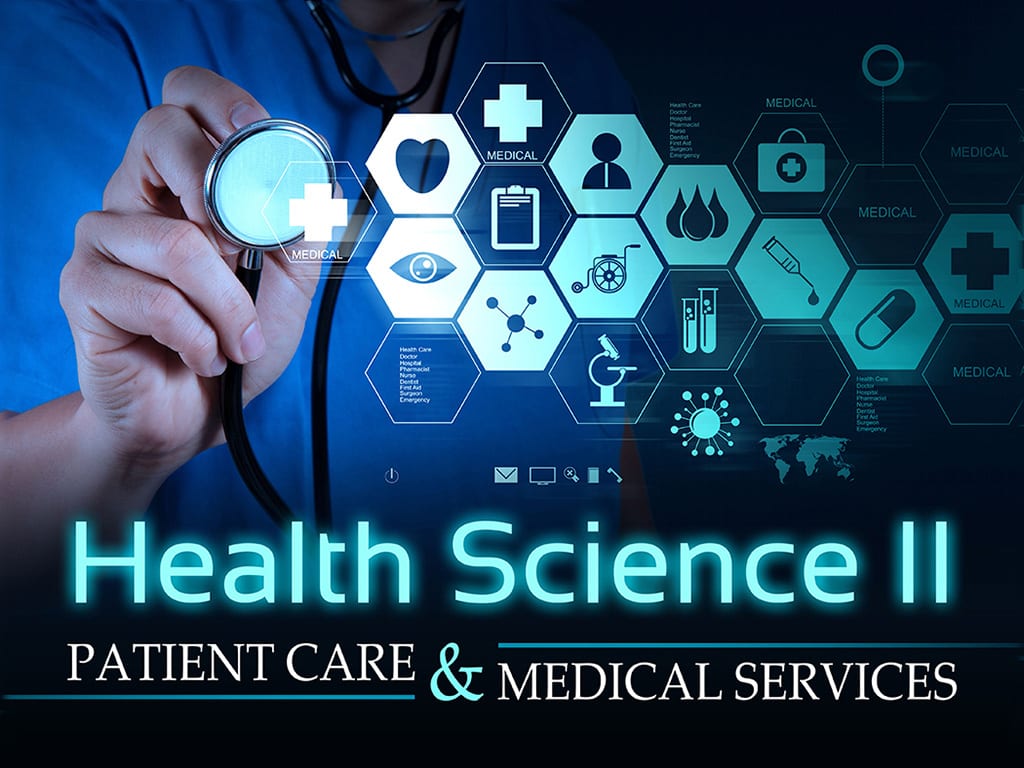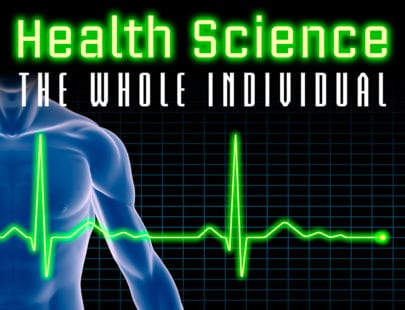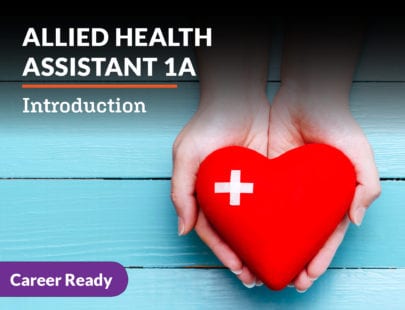
Health Science II: Patient Care and Medical Services
Explore the roles health care professionals play in treating patients. Promoting wellness, communicating with patients, and understanding safety in the workplace are just a few of the essential skills you will learn, all the while becoming familiar with some of the more prominent areas in the field, such as emergency care, nursing, infection control, and pediatrics. You’ll learn about some of the inherent challenges faced by this age-old profession and how you can become a significant part of the solution.
Units at a Glance
Unit 1: Health Care Systems
Health services is one of the fastest-growing industries in the United States, and this unit explores the ways in which these services are delivered. Health insurance is an important part of the industry, and there are several types to meet patient’s’ needs. Taking care of patients is not just up to doctors; it requires a team of health care professionals to ensure patients’ needs are met. For this team to be effective, the patient needs to work with the team and do his or her part to help the team deliver the most effective care. As with all industries, health science adapts with the times, including responding to new legislation, using technology to improve services, and responding to pressing health issues.
What will you learn in this unit?
- Identify the basic components of the health care delivery system, including public, private, government, and nonprofit sectors.
- Discuss common methods of payment for health care services.
- Describe the composition and functions of a health care team.
- Explain factors that influence the current delivery system of health care.
- Interpret the impact of emerging issues—including technology, epidemiology, bioethics, and socioeconomics—on health care delivery systems.
Unit 2: Communication in Health Care
This unit explores the importance of communication skills in the health science field. One of the first steps is using the specific language of the medical professions. This shared language helps health care workers communicate with each other. However, many professionals will spend a lot of time communicating with patients. Understanding the basics of effective communication can help health care professionals get the information they need to best serve their patients. In addition, recognizing some of the reasons that communication breaks down lets health science professionals avoid some of these common issues.
What will you learn in this unit?
- Correctly use appropriate medical terminology and abbreviations.
- Explain the importance of patient/client education regarding health care.
- Develop basic speaking and active listening skills.
- Analyze elements of communication using a sender–receiver model.
- Distinguish between and report on subjective and objective information.
Unit 3: Legal Responsibilities & Patients’ Rights
This unit explores the various ways in which health care is regulated and the obligations these requirements create for the members of the health care team. The standard for patient care is defined at many levels, ranging from federal law to the rules of an individual health care facility. Not only to health care professionals need to know all relevant laws, but they also need to inform patients of their rights while undergoing medical treatment.
What will you learn in this unit?
- Discuss the legal framework of the health care occupations, including scope-of-practice legislation.
- Recognize practices that could result in malpractice, liability, negligence, abandonment, false imprisonment, and fraud.
- Identify standards of the Health Insurance Portability and Accountability Act (HIPAA).
- Explain the Patient’s Bill of Rights.
- Describe advance directives.
Unit 4: Heath Care Workers’ Responsibilities in the Workplace
This unit explores the laws designed to protect employees in health care, including their right to a safe workplace that is free of harassment. At the same time, employees in health care need to be particularly mindful of the professional ethics that define how they perform their duties. Those in health care will face a variety of ethical issues in the course of their jobs since life or death choices are part of the job. Legal and ethical obligations work together, providing the guidelines those in the field need to effectively care for patients. These ethics also help shape employee behavior, particularly in essential areas like the handling controlled substances where accountability is key.
What will you learn in this unit?
- Explain the laws governing harassment, labor, and employment.
- Differentiate between legal and ethical issues in health care.
- Recognize and learn how to report illegal or unethical practices of health care workers.
- Identify and compare personal, professional, and organizational ethics.
- Distinguish among the five schedules of controlled substances.
Unit 5: Wellness
This unit explores the principle of wellness, and what it takes to be physically and mentally healthy. Regular screening and examinations are an essential part of the equation, as is attention to diet and exercise. These health habits really make a difference over the course of a lifetime. Avoiding high-risk behavior, such as smoking, consuming alcohol and taking illegal drugs, also makes for a longer and healthier life. Managing stress, even in extreme circumstances, such as after the death of a loved one, is also an important skill. When individuals take these steps to maintain wellness, they are paving the way for a long and healthy life. In addition to traditional medical practice, for an increasing number of Americans, personal wellness also depends on using alternative medicine to promote health and wellness.
What will you learn in this unit?
- Describe strategies for prevention of diseases, including health screenings and examinations.
- Discuss the adverse effects of the use of alcohol, tobacco, and both legal and illegal drugs on the human body, and apply safety practices related to these and other high-risk behaviors.
- Explain the basic concepts of positive self-image, wellness, and stress.
- Develop a wellness and stress-control plan that can be used in personal and professional life.
- Recognize the steps in the grief process.
Unit 6: Workplace Safety
This unit explores the many safety practices put into place by OSHA and the CDC to protect those working in health care on the job. Safety comes through proper training on managing common hazards in the workplace, such as working with chemicals and moving heavy objects or patients. Creating a safe environment is not just for employees; health care workers need to keep their own, coworker’s, and patient’s safety in mind as well. Making sure that they avoid common medical errors and follow recommended guideline for identifying patients help make patients safer while they are in medical facilities. Guidelines for moving patients also benefit employees and patients since they eliminate the chance of injury for both. In the event of an emergency, health care workers need to be able to take care of themselves and their patients, so knowing emergency procedures is also part of a career in the health sciences.
What will you learn in this unit?
- Recognize safe and unsafe working conditions and know how to report safety hazards.
- Identify and describe methods in medical error reduction and prevention in various health care settings.
- Follow Materials Data Safety sheets (MSDS) and comply with safety signs, symbols, and labels.
- Demonstrate proper body mechanics and ergonomics.
- Implement fire, safety, disaster, and evacuation procedures.
Unit 7: Emergency Care and Infection Control
This unit explores the basic process of administering first aid and when it is appropriate to offer emergency treatment to a stranger in public. It also defines the vital signs and provides basic instructions for taking and recording them. Understanding the role of microbes and how they move through the environment allows those in health care to limit their spread through sterilization processes, hand washing, and appropriate disposal of biohazardous materials. When these steps are taking, the environment is safer for everyone. When problems do emerge in a health care setting, turning to root cause analysis offers valuable insight into the core issues creating the problems. Only when these are identified can productive solutions be put in place.
What will you learn in this unit?
- Describe legal parameters relating to the administration of emergency care.
- Monitor and record vital signs.
- Define principles of infection control, including standard and transmission-based precautions.
- Demonstrate knowledge of medical asepsis and practice procedures, such as hand-washing and isolation.
- Explain and apply the theory of root-cause analysis.
Unit 8: Technology in Health Care and Medical Math
This unit explores the role of technology in healthcare, particularly the kinds of computers that health care professionals with use to perform the basic duties of their jobs. Computers are used for everything from recording information to diagnosing medical problems, so those in working in health care need to be able to used them effectively. One of the most common uses of technology is communication, whether it is researchers sharing medical breakthroughs around the world of patients being able to communicate more effectively with their own doctors. As valuable as technology is, those in health care still need to use their basic math skills. Understanding basic principles, like ratios, or how to convert pounds to kilograms ensures that medical professionals have the skills that they need to get the job done.
What will you learn in this unit?
- Describe technology applications in health care.
- Measure time, temperature, distance, capacity, and mass/weight.
- Evaluate data and draw conclusions.
- Construct viable arguments and critique the reasoning of others.
- Organize and communicate the results obtained by observation and experimentation.
Unit 9: Blood-borne Illnesses
This unit examines the most common blood-borne illnesses, including HIV/AIDS, and hepatitis B and C. Understanding how these viruses are transmitted is one of the most important steps in preventing their spread. There are specific behaviors that aid the spread of these diseases, and health care professionals have an obligation to educate patients about what they need to do to reduce these risks. There are also specific processes that need to be followed when testing patients for blood-borne illnesses. Because these diseases pose a risk to health care workers, they also need to know who to protect themselves and the actions to take should they be in danger of infection.
What will you learn in this unit?
- Demonstrate knowledge of the legal aspects of HIV/AIDS, including testing.
- Identify community resources and services available to individuals with diseases caused by blood-borne pathogens.
- Recognize at-risk behaviors that promote the spread of diseases caused by blood-borne pathogens, and the public health education necessary to combat the spread of these diseases.
- Apply infection control techniques designed to prevent the spread of diseases caused by blood-borne pathogens to the care of all patients following CDC guidelines.
- Recognize emerging diseases and disorders.
Unit 10: Getting a Job in the Health Care Industry
This unit explores expectation of professional conduct in the health care industry, including personal qualities of health care workers and attention to personal presentation. It also emphasizes the importance of teamwork and the components of effective leadership. Students will get an overview of the multiple career paths available in health care and understand the process of looking and applying for a job. This included an overview of the education and credentialing requirements in health care and how to navigate the application process.
What will you learn in this unit?
- Demonstrate the personal traits or attitudes desirable in a member of the health care team.
- Discuss levels of education; credentialing requirements, including licensure and certification; employment opportunities; workplace environments; and career growth potential.
- Compare careers within the health science career pathways (diagnostic services, therapeutic services, health informatics, support services, biotechnology research and development).
- Develop a job-specific résumé.
- Identify characteristics of effective teams.
Required Materials
- Microsoft Word or another document software



